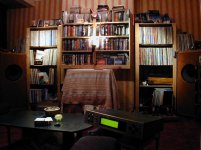Folks,
At the other thread I noticed interest in what may be called a "functional clone" of the Cello palette. Please review the High End Tone Control thread for background information and the options discussed:
http://www.diyaudio.com/forums/analog-line-level/194119-high-end-tone-control.html
The Palette is best described as a Stereo Mastering EQ designed for easy and intuitive use by non-engineers (most EQ's need operators with at least two degrees and many years of experience to get suitable results). One way to describe the actions of the six controls of the Palette approximately is:
Bass [20Hz]
Drum [120Hz]
Lower Voice [500Hz]
Presence [2Khz]
Rasp [5KHz]
Air [20KHz]
Control ranges are 'weighted' so that any changes for a given rotation in for example the "presence" band are much smaller than the "bass" band, relating directly to the behaviour of the human hearing. The Palette has possibly more adjustment range than is beneficial and due to a number of factors a true clone is jut not a sensible option nor is it necessary.
Here the original:
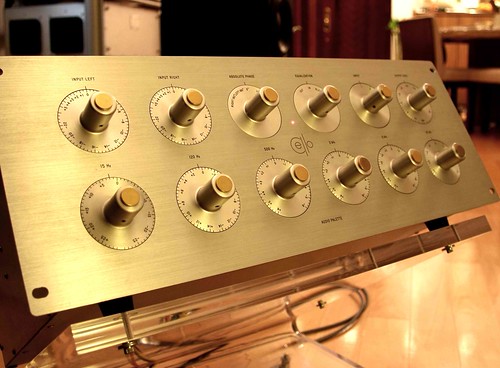
In principle we can realise something that follows most of the Palette design brief using any technology we care to apply, so much is established.
However "Vita brevis, ars longa" dictate that we cannot spend time, effort and money on making a Palette functional clone with each and every available technology and then to let everyone choose which design suits them best.
So for starters we set the following outline for the actual EQ function:
Centre frequencies:
20Hz +/- 12 ... 18dB
120Hz +/- 6 ... 9dB
500Hz +/- 3 ... 5.5dB
2KHz +/- 3 ... 5.5dB
5KHz +/- 6 ... 9dB
20KHz +/- 12 ... 18dB
We can make bands somewhat adjustable using switches if desired.
Adjustment range is open to some debate as well.
Controls should be able to use generally available potentiometers but can be implemented also with rotary switches.
If we limit ourselves to 24-Pole switches (actually 23 Poles usable) this gives us +/- 11 positions for boost/cut.
This suggests 0.4dB steps for the innermost bands (so +/- 4.4dB), 0.8dB steps for the intermediate bands (so +/- 8.8dB) and 1.2dB steps for the extreme bands (so +/- 13.2dB).
If these items are agreeable we can proceed to select the electronic circuitry, here is where the poll comes in. If you are interested in this analogue (re)mastering EQ project, please vote in the poll on the technology to be used. the poll is multi-choice to perhaps vote 1st & 2nd choice...
Ciao T
At the other thread I noticed interest in what may be called a "functional clone" of the Cello palette. Please review the High End Tone Control thread for background information and the options discussed:
http://www.diyaudio.com/forums/analog-line-level/194119-high-end-tone-control.html
The Palette is best described as a Stereo Mastering EQ designed for easy and intuitive use by non-engineers (most EQ's need operators with at least two degrees and many years of experience to get suitable results). One way to describe the actions of the six controls of the Palette approximately is:
Bass [20Hz]
Drum [120Hz]
Lower Voice [500Hz]
Presence [2Khz]
Rasp [5KHz]
Air [20KHz]
Control ranges are 'weighted' so that any changes for a given rotation in for example the "presence" band are much smaller than the "bass" band, relating directly to the behaviour of the human hearing. The Palette has possibly more adjustment range than is beneficial and due to a number of factors a true clone is jut not a sensible option nor is it necessary.
Here the original:

In principle we can realise something that follows most of the Palette design brief using any technology we care to apply, so much is established.
However "Vita brevis, ars longa" dictate that we cannot spend time, effort and money on making a Palette functional clone with each and every available technology and then to let everyone choose which design suits them best.
So for starters we set the following outline for the actual EQ function:
Centre frequencies:
20Hz +/- 12 ... 18dB
120Hz +/- 6 ... 9dB
500Hz +/- 3 ... 5.5dB
2KHz +/- 3 ... 5.5dB
5KHz +/- 6 ... 9dB
20KHz +/- 12 ... 18dB
We can make bands somewhat adjustable using switches if desired.
Adjustment range is open to some debate as well.
Controls should be able to use generally available potentiometers but can be implemented also with rotary switches.
If we limit ourselves to 24-Pole switches (actually 23 Poles usable) this gives us +/- 11 positions for boost/cut.
This suggests 0.4dB steps for the innermost bands (so +/- 4.4dB), 0.8dB steps for the intermediate bands (so +/- 8.8dB) and 1.2dB steps for the extreme bands (so +/- 13.2dB).
If these items are agreeable we can proceed to select the electronic circuitry, here is where the poll comes in. If you are interested in this analogue (re)mastering EQ project, please vote in the poll on the technology to be used. the poll is multi-choice to perhaps vote 1st & 2nd choice...
Ciao T
Last edited:
Hi,
Top of this page?
How about concrete suggestions?
Ciao T
Great idea Thorsten, but what poll?
Top of this page?
Let's not re-invent the wheel. I say optimised op-amps of the best sounding types available today used in Jung multi-loop configuration with separate high current buffers.
How about concrete suggestions?
Ciao T
Hi,
Please see the first post and the link to the original tone-control thread.
It includes this schematic:
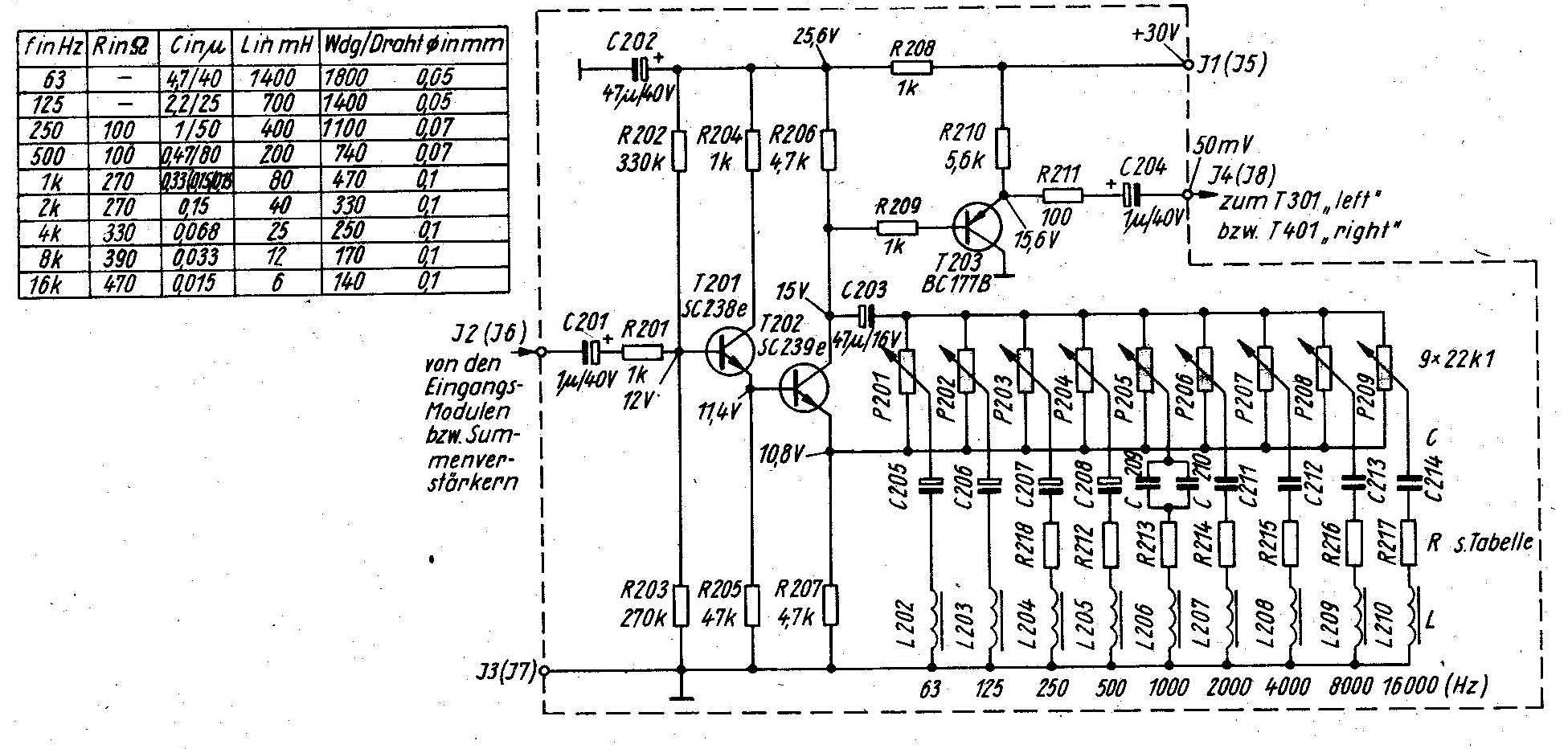
I called it "East German EQ" because that is what it is. It was designed in East Germany in the late 70's and remains somewhat legendary for it's sound quality. It avoids the use of looped feedback, which similar western Pro-Audio design already used in massive amounts routinely. I can attest to the sonics of this type of EQ, I used it extensively.
This EQ shows the principles for what "ZenEQ" (Solid State) and the "HotEQ" (Tubed).
The circuit can be realised using only two N-Channel devices per channel, or if we want to very Zen, we can get away with one device (but must provide a tightly defined load).
The chokes in the filters can be replaced by Gyrators, using even single J-Fets. I would attempt to retain real chokes for as many bands as possible though.
It appears ZEQ/HEQ is currently ahead in the poll, the advantage is that that linear track pots may be used and few parts are required. The downside is that the active section must be designed in. So a Tube version would be a distinct Fork, the Fet version another.
Ciao T
What is an "East German EQ"?
Sounds somehow retro sylish to me!
Please see the first post and the link to the original tone-control thread.
It includes this schematic:

I called it "East German EQ" because that is what it is. It was designed in East Germany in the late 70's and remains somewhat legendary for it's sound quality. It avoids the use of looped feedback, which similar western Pro-Audio design already used in massive amounts routinely. I can attest to the sonics of this type of EQ, I used it extensively.
This EQ shows the principles for what "ZenEQ" (Solid State) and the "HotEQ" (Tubed).
The circuit can be realised using only two N-Channel devices per channel, or if we want to very Zen, we can get away with one device (but must provide a tightly defined load).
The chokes in the filters can be replaced by Gyrators, using even single J-Fets. I would attempt to retain real chokes for as many bands as possible though.
It appears ZEQ/HEQ is currently ahead in the poll, the advantage is that that linear track pots may be used and few parts are required. The downside is that the active section must be designed in. So a Tube version would be a distinct Fork, the Fet version another.
Ciao T
Slaughter a used DN27AThe "East German EQ' uses good'ol inductors. Are you aware of a modern day source for them?
Please also read this thread
I can testify that the level-weighted soft-Q adjustments really can do what normal tonecontrols cannot.
The range on mine is similar to the original Audio palette, and eventhough it is rare that I use the full range it is sometimes needed (especially in the two lower bands). It is the case with some music mastered for the American market that you want to play with "European" sound.
So my advice: Don't choose to low a dB-range for the controls. With that many positions one can easily get satisfyingly small corrections when called for.
I can testify that the level-weighted soft-Q adjustments really can do what normal tonecontrols cannot.
The range on mine is similar to the original Audio palette, and eventhough it is rare that I use the full range it is sometimes needed (especially in the two lower bands). It is the case with some music mastered for the American market that you want to play with "European" sound.
So my advice: Don't choose to low a dB-range for the controls. With that many positions one can easily get satisfyingly small corrections when called for.
Hi,
The winding data for the east german EQ is included, sadly no direct info on the cores, however you can work that out indirectly, then adjust for available cores and wind your own... They where small so-called Pot-Cores.
I have some connections to custom inductors in modest quantities, so I am sure they could made available for a group-buy (PCB's too).
I think the LF bands (20 & 120Hz) sadly would have to use gyrators though.
Ciao T
The "East German EQ' uses good'ol inductors. Are you aware of a modern day source for them?
I like the old inductor EQs. In my experience the opamp gyrator equivalents just don't sound as good.
The winding data for the east german EQ is included, sadly no direct info on the cores, however you can work that out indirectly, then adjust for available cores and wind your own... They where small so-called Pot-Cores.
I have some connections to custom inductors in modest quantities, so I am sure they could made available for a group-buy (PCB's too).
I think the LF bands (20 & 120Hz) sadly would have to use gyrators though.
Ciao T
As I understand this, the primary duty of the "Tone Stack/Control" is to correct recording anamolies but my speakers fall off pretty quickly below 34Hz, would it be better to move the lower 20Hz filter up to at least 34Hz for my system? And the next speakers I have in mind require the Link Transform eq (the B2 alignment, closed box design and would this conflict with this tone control design?
Having to work with a "Sea of Knobs" for years, it's not something I want to do at home - you just don't bother after a while.
Having to work with a "Sea of Knobs" for years, it's not something I want to do at home - you just don't bother after a while.
> It was designed in East Germany in the late 70's and remains somewhat legendary for it's sound quality. It avoids the use of looped feedback, which similar western Pro-Audio design already used in massive amounts routinely. I can attest to the sonics of this type of EQ, I used it extensively.
For a High End solid state design, I would have thought that one would want to at least get rid of the coupling caps ??
Patrick
For a High End solid state design, I would have thought that one would want to at least get rid of the coupling caps ??
Patrick
Hi,
One could include suitable circuits after the actual control, such a combination of Speaker LF EQ and Highpass. I would not as such change the Centre frequencies of the EQ.
It depends, I find I did when I used a Behringer DEQ in a similar style/application... The use must be quick, intuitive and easy, the EQ must be easily available.
Ciao T
As I understand this, the primary duty of the "Tone Stack/Control" is to correct recording anamolies but my speakers fall off pretty quickly below 34Hz, would it be better to move the lower 20Hz filter up to at least 34Hz for my system? And the next speakers I have in mind require the Link Transform eq (the B2 alignment, closed box design and would this conflict with this tone control design?
One could include suitable circuits after the actual control, such a combination of Speaker LF EQ and Highpass. I would not as such change the Centre frequencies of the EQ.
Having to work with a "Sea of Knobs" for years, it's not something I want to do at home - you just don't bother after a while.
It depends, I find I did when I used a Behringer DEQ in a similar style/application... The use must be quick, intuitive and easy, the EQ must be easily available.
Ciao T
Attachments
Hi,
Why? As I routinely work with Tubes I have no irrational fear of coupling capacitors. Often, but not always they are a better choice than the direct coupling alternatives, which in actually still have coupling cap's, but so to speak "hidden from sight".
I notice Papa Pass's "Zen" range also has coupling cap's...
FWIW, the point is not to copy the East German design exactly, but to use the principles embodied. It would be possible to make a fully DC coupled circuit using rail symmetrical folded cascodes. But this would need a DC servo which I find most of the time worse than a high quality coupling cap. Complementary FEt's that are suited are also becoming hard to find. And I'd rather like to keep a level of simplicity that parallels the Pass B1.
I am sure what I can do with eight or nine J-Fets or less if I add some inductors and a handful of resistors and capacitors can be extended into something that requires over 30 Op-Amp's and offers less functionality and worse subjective sound quality, but I'll leave that sort of thing to those who have made it their life's work.
Ciao T
For a High End solid state design, I would have thought that one would want to at least get rid of the coupling caps ??
Why? As I routinely work with Tubes I have no irrational fear of coupling capacitors. Often, but not always they are a better choice than the direct coupling alternatives, which in actually still have coupling cap's, but so to speak "hidden from sight".
I notice Papa Pass's "Zen" range also has coupling cap's...
FWIW, the point is not to copy the East German design exactly, but to use the principles embodied. It would be possible to make a fully DC coupled circuit using rail symmetrical folded cascodes. But this would need a DC servo which I find most of the time worse than a high quality coupling cap. Complementary FEt's that are suited are also becoming hard to find. And I'd rather like to keep a level of simplicity that parallels the Pass B1.
I am sure what I can do with eight or nine J-Fets or less if I add some inductors and a handful of resistors and capacitors can be extended into something that requires over 30 Op-Amp's and offers less functionality and worse subjective sound quality, but I'll leave that sort of thing to those who have made it their life's work.
Ciao T
Great project; some questions:
I take your point that one can use a high pass filter after the EQ
(adds another stage though) and cello uses 20Hz too, but if I have for
example a ported box tuned to 40 Hz, I would not expect any useful output at 20Hz while
probably some adjustment at 40 Hz would be nice to have. The East German EQ
uses 63 Hz (probably a bit high) and the Neumann W491 45 Hz.
Are there plans to have the lowest center frequency adjustable,
let´s say 20-40 Hz ?
You mentioned the use of FETs, which do you have in mind (so we can
buy some as long they are available) ?
I take your point that one can use a high pass filter after the EQ
(adds another stage though) and cello uses 20Hz too, but if I have for
example a ported box tuned to 40 Hz, I would not expect any useful output at 20Hz while
probably some adjustment at 40 Hz would be nice to have. The East German EQ
uses 63 Hz (probably a bit high) and the Neumann W491 45 Hz.
Are there plans to have the lowest center frequency adjustable,
let´s say 20-40 Hz ?
You mentioned the use of FETs, which do you have in mind (so we can
buy some as long they are available) ?
How is this thread any different from the other one? It's already turning into a talking shop with everyone putting their bit in but nothing getting decided. There'll be 10 or so pages of this then it will fizzle out like the other thread.
Oh and Thorsten - I did make concrete suggestions. Look again. If you want part numbers how about OPA627 with a National buffer or the AD 811 or AD815 if you want to use multiloop.
Oh and Thorsten - I did make concrete suggestions. Look again. If you want part numbers how about OPA627 with a National buffer or the AD 811 or AD815 if you want to use multiloop.
Last edited:
Folks,
I had the chance today to run the "ZenEQ" concept through Tina-Ti. This is not necessarily meant to be a final design, rather a quick study how a simple circuit may perform.
This reminded me that if we require a more or less proportionate boost in dB vs. rotation we need to use potentiometers that are "S" curve, not linear. These are hard to get these days.
If using linear pots then the adjustment range gets bunched up towards the extremes. This is not necessarily a bad thing, as it makes very small adjustments very precise, the downside is that if we need a lot of correction we are left with very little usable travel.
If using switches as controls this is of course of no consequence at all, as we simply can select the correct resistances to give correct dB/vs. Attenuation.
Attached is Tina-Ti File I used (needs latest version) and some simulation results, all using 10K//1nF load. I am not sure how accurate the models buld into Tina-Ti are etc., but it would seem okayish for ballpark.
I would specify 2SK170 BL or V for the circuit, Tina-Ti lacks the model, so I made up a compound from 2N3819 & a PNP BJT, 2SK170 will show worse THD. I am for now showing ideal chokes, they can be replaced by gyrators, but I lack the time right now. For the LF choke 2H with < 120 Ohm DCR are needed, I do have a few such around, so we know they can be made.
The schematic looks like this:
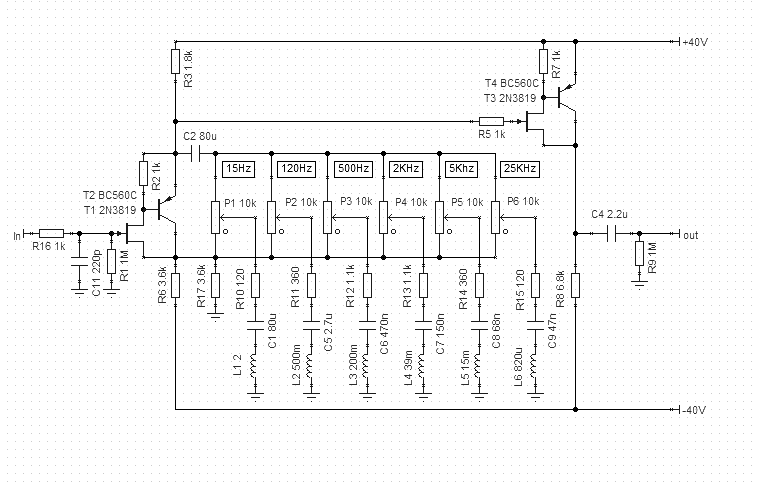
The curves produced by stepping the pots in 10% intervals (this is equivalent to rotating linear pots 10% of the rotation for each step):
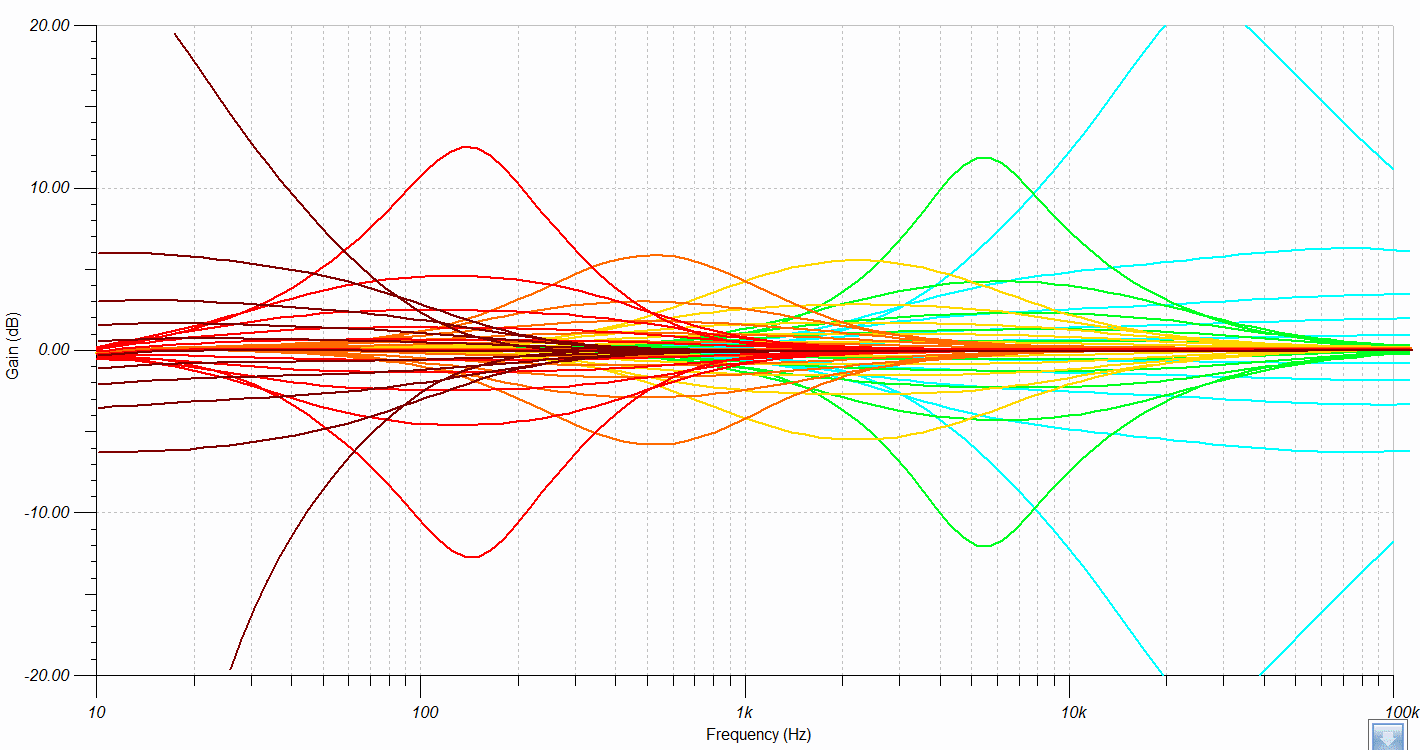
The frequency response with controls perfectly centred (impossible with pots) looks like this:
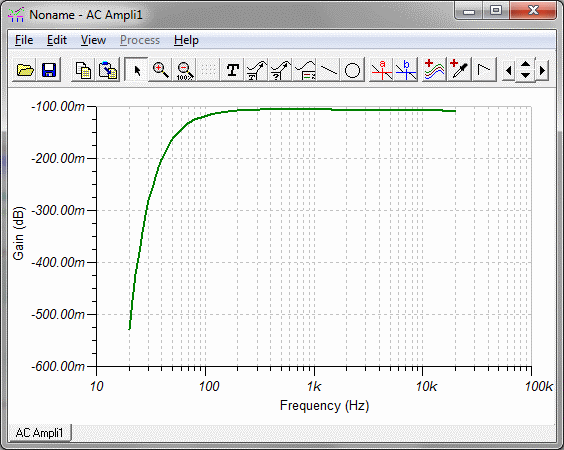
The LF rolloff is a result of the 2.2uF coupling capacitors shown. I habitually use this value, it works fine IME.
To illustrate two interesting EQ results, here what it looks like with all controls set halfway towards maximum cut from neutral:
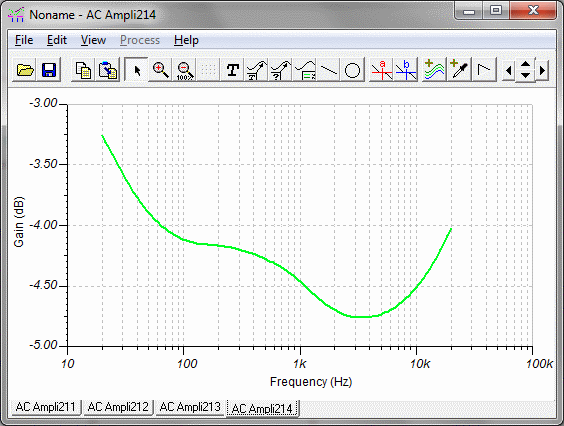
This illustrates rather well how the various bands combine and with a weighting that is similar to the ISO Equal loudness peaks and through...
And here a EQ setting that can help with modern overproduced recordings, by cutting back presence and "kick" bass, and dialing the extremes up, all just a touch:
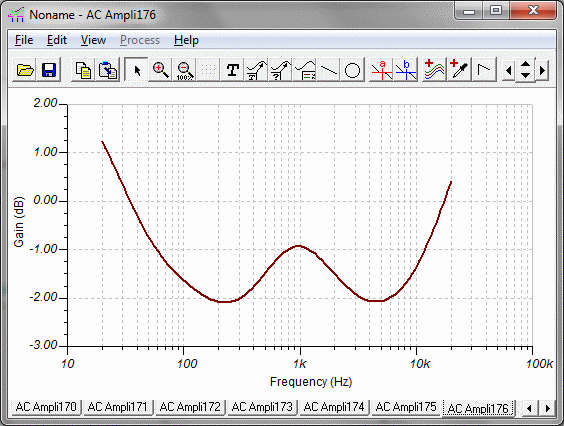
The required pot settings for this (0 = centre, 0.5 is half way between zero and the respective end, linear pots assumed) are:
15Hz = +0.5
120Hz = -0.5
500Hz = +0.2
2KHz = 0.0
5KHz = -0.8
20KHz = +0.6
Here harmonics for 1V out which adds up to 0.005% THD according to Tina-Ti:
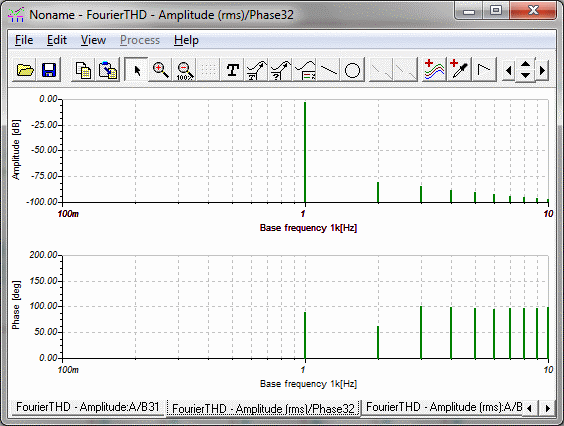
and for 4V out which adds up to 0.05% THD according to Tina-Ti:
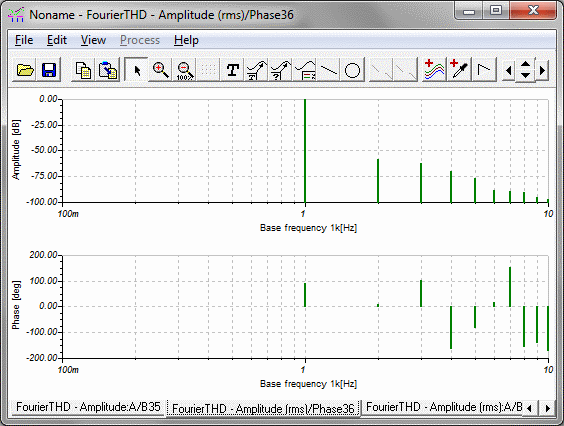
Clipping (1% THD) is at 5V.
Tina-Ti has a seriously funky way of showing noise, anyway, it works out ot -120dB unweighted re. 1V, which seems too good to be true. Still, might be on the money:
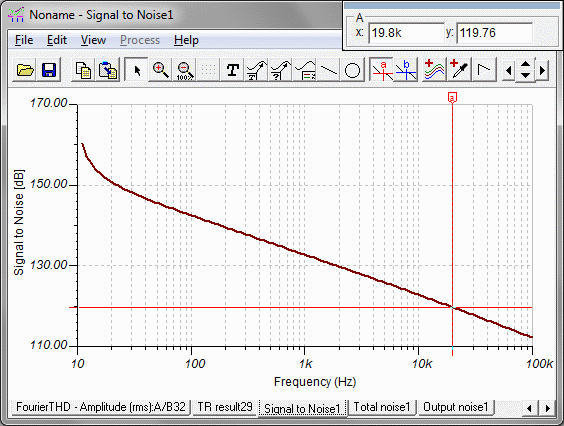
I hope all of this gives people some ideas for the "ZenEQ" and what sort result could be possible, to see if it is worth proceeding. To me the performance looks acceptable, we can get better measured results using Op-Amp's, but I doubt the sound will be improved.
Ciao T
I had the chance today to run the "ZenEQ" concept through Tina-Ti. This is not necessarily meant to be a final design, rather a quick study how a simple circuit may perform.
This reminded me that if we require a more or less proportionate boost in dB vs. rotation we need to use potentiometers that are "S" curve, not linear. These are hard to get these days.
If using linear pots then the adjustment range gets bunched up towards the extremes. This is not necessarily a bad thing, as it makes very small adjustments very precise, the downside is that if we need a lot of correction we are left with very little usable travel.
If using switches as controls this is of course of no consequence at all, as we simply can select the correct resistances to give correct dB/vs. Attenuation.
Attached is Tina-Ti File I used (needs latest version) and some simulation results, all using 10K//1nF load. I am not sure how accurate the models buld into Tina-Ti are etc., but it would seem okayish for ballpark.
I would specify 2SK170 BL or V for the circuit, Tina-Ti lacks the model, so I made up a compound from 2N3819 & a PNP BJT, 2SK170 will show worse THD. I am for now showing ideal chokes, they can be replaced by gyrators, but I lack the time right now. For the LF choke 2H with < 120 Ohm DCR are needed, I do have a few such around, so we know they can be made.
The schematic looks like this:
The curves produced by stepping the pots in 10% intervals (this is equivalent to rotating linear pots 10% of the rotation for each step):
The frequency response with controls perfectly centred (impossible with pots) looks like this:
The LF rolloff is a result of the 2.2uF coupling capacitors shown. I habitually use this value, it works fine IME.
To illustrate two interesting EQ results, here what it looks like with all controls set halfway towards maximum cut from neutral:
This illustrates rather well how the various bands combine and with a weighting that is similar to the ISO Equal loudness peaks and through...
And here a EQ setting that can help with modern overproduced recordings, by cutting back presence and "kick" bass, and dialing the extremes up, all just a touch:
The required pot settings for this (0 = centre, 0.5 is half way between zero and the respective end, linear pots assumed) are:
15Hz = +0.5
120Hz = -0.5
500Hz = +0.2
2KHz = 0.0
5KHz = -0.8
20KHz = +0.6
Here harmonics for 1V out which adds up to 0.005% THD according to Tina-Ti:
and for 4V out which adds up to 0.05% THD according to Tina-Ti:
Clipping (1% THD) is at 5V.
Tina-Ti has a seriously funky way of showing noise, anyway, it works out ot -120dB unweighted re. 1V, which seems too good to be true. Still, might be on the money:
I hope all of this gives people some ideas for the "ZenEQ" and what sort result could be possible, to see if it is worth proceeding. To me the performance looks acceptable, we can get better measured results using Op-Amp's, but I doubt the sound will be improved.
Ciao T
Attachments
-
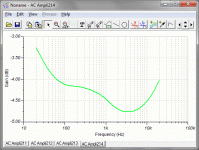 All controls -0.5.gif31.1 KB · Views: 3,809
All controls -0.5.gif31.1 KB · Views: 3,809 -
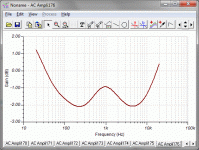 Anti-Presence-EQ.gif32 KB · Views: 3,808
Anti-Presence-EQ.gif32 KB · Views: 3,808 -
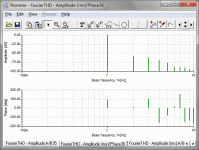 THD 4V.gif31.5 KB · Views: 3,768
THD 4V.gif31.5 KB · Views: 3,768 -
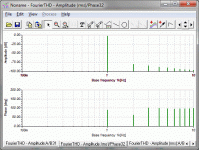 THD 1V.gif34.2 KB · Views: 3,767
THD 1V.gif34.2 KB · Views: 3,767 -
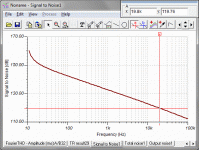 SNR 1V.gif28.7 KB · Views: 3,773
SNR 1V.gif28.7 KB · Views: 3,773 -
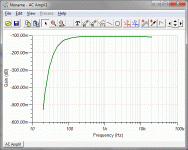 Frequency Response.gif30 KB · Views: 3,824
Frequency Response.gif30 KB · Views: 3,824 -
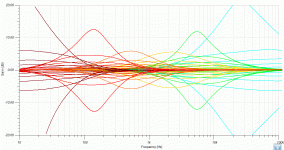 Compound.gif36.4 KB · Views: 3,933
Compound.gif36.4 KB · Views: 3,933 -
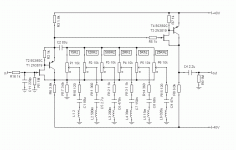 ZenEQ.gif15 KB · Views: 4,476
ZenEQ.gif15 KB · Views: 4,476 -
ZenEQ.zip4.1 KB · Views: 221
Hi,
That is probably my fault. I refuse "to lead" and to be the one who lays the down guru style on how it can only "one way, this way and no other". I'd rather people find THEIR way. Hence i gave many options and ways.
Anyway, what I can contribute for now is on the table. True, I assume that there will be some of the least common of all senses applied when using the circuit I suggest, no attempts to drive headphones directly off the output of the EQ and other such sillyness.
Anyone wants to do something Op-Amp based instead, on a similar level, please chip in...
Ciao T
There'll be 10 or so pages of this then it will fizzle out like the other thread.
That is probably my fault. I refuse "to lead" and to be the one who lays the down guru style on how it can only "one way, this way and no other". I'd rather people find THEIR way. Hence i gave many options and ways.
Anyway, what I can contribute for now is on the table. True, I assume that there will be some of the least common of all senses applied when using the circuit I suggest, no attempts to drive headphones directly off the output of the EQ and other such sillyness.
Anyone wants to do something Op-Amp based instead, on a similar level, please chip in...
Ciao T
ThorstenL,
Please continue working up your FET & inductor solution. I've got a stash of suitable inductors leftover from the old days when I had an Auditronics 36 Grand mixing console. The EQ in that console was the reason that I kept it so long. I still have a stash of parts hoarded away. I have stash of FETs as well. If you complete the design I will be sure to build it.
Please continue working up your FET & inductor solution. I've got a stash of suitable inductors leftover from the old days when I had an Auditronics 36 Grand mixing console. The EQ in that console was the reason that I kept it so long. I still have a stash of parts hoarded away. I have stash of FETs as well. If you complete the design I will be sure to build it.
- Home
- Source & Line
- Analog Line Level
- Cello Palette Style EQ Design (was High End Tone Control)...
